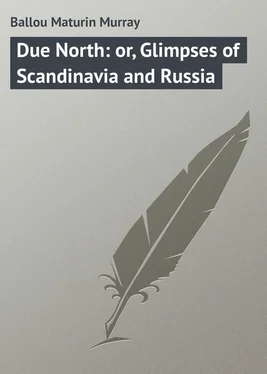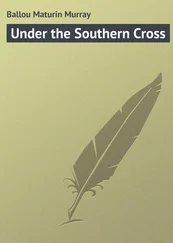Maturin Ballou - Due North - or, Glimpses of Scandinavia and Russia
Здесь есть возможность читать онлайн «Maturin Ballou - Due North - or, Glimpses of Scandinavia and Russia» — ознакомительный отрывок электронной книги совершенно бесплатно, а после прочтения отрывка купить полную версию. В некоторых случаях можно слушать аудио, скачать через торрент в формате fb2 и присутствует краткое содержание. Жанр: foreign_prose, Путешествия и география, на английском языке. Описание произведения, (предисловие) а так же отзывы посетителей доступны на портале библиотеки ЛибКат.
- Название:Due North: or, Glimpses of Scandinavia and Russia
- Автор:
- Жанр:
- Год:неизвестен
- ISBN:нет данных
- Рейтинг книги:3 / 5. Голосов: 1
-
Избранное:Добавить в избранное
- Отзывы:
-
Ваша оценка:
- 60
- 1
- 2
- 3
- 4
- 5
Due North: or, Glimpses of Scandinavia and Russia: краткое содержание, описание и аннотация
Предлагаем к чтению аннотацию, описание, краткое содержание или предисловие (зависит от того, что написал сам автор книги «Due North: or, Glimpses of Scandinavia and Russia»). Если вы не нашли необходимую информацию о книге — напишите в комментариях, мы постараемся отыскать её.
Due North: or, Glimpses of Scandinavia and Russia — читать онлайн ознакомительный отрывок
Ниже представлен текст книги, разбитый по страницам. Система сохранения места последней прочитанной страницы, позволяет с удобством читать онлайн бесплатно книгу «Due North: or, Glimpses of Scandinavia and Russia», без необходимости каждый раз заново искать на чём Вы остановились. Поставьте закладку, и сможете в любой момент перейти на страницу, на которой закончили чтение.
Интервал:
Закладка:
CHAPTER II
Copenhagen is not without its ballets, theatres, Alhambras, Walhallas, and cafés chantants . The principal out-door resort of this character is the Tivoli Gardens, laid out in the Moorish style, where the citizens, representing all classes, – the cultured, the artisan, and the peasant, – assemble and mingle together in a free-and-easy way. Here they enjoy the long summer evenings, which indeed at this season of the year do not seem like evenings at all, since they are nearly as light as the day. Whatever may be said in advocacy of these public assemblies, enjoyed amid the trees, flowers, soft air, and artistic surroundings, there seems to a casual visitor to be too much freedom permitted between the sexes for entire respectability, and yet nothing actually repulsive was observable. In Berlin or Vienna these popular resorts would be designated as beer gardens; here they are called tea-gardens. The Tivoli has a fine ballet troup among its attractions, and employs two orchestras of forty instrumental performers each, stationed in different parts of the spacious gardens. The price of admission to these illuminated grounds is merely nominal. Some of the wealthiest families as well as the humbler bring their children with them, as is the custom of those who frequent the beer gardens of Munich and Dresden. As a popular place of varied and attractive amusements the Tivoli of Copenhagen has hardly its equal in Europe.
Just across the harbor is the spacious and fertile island of Amager, some twenty square miles in extent, which serves as the kitchen or vegetable garden of the capital. It was first occupied by a colony of Flemings who were brought hither in 1516 by Charles II., for the purpose of teaching his subjects how to cultivate vegetables and flowers. The descendants of these foreigners still retain traces of their origin, remaining quite distinctive in their costume and personality. These peasants, or at least those who daily come to market, must be well off in a pecuniary sense, judging by their gold and silver ornaments and fanciful dresses.
Tramways render all parts of the city and environs accessible, the double-decked cars enabling them to carry a large number of passengers. Broad streets and convenient sidewalks invite the promenaders along the open squares, which are frequently lined with umbrageous trees and embellished with monuments. The fashionable drive and promenade is the Lange Linie (that is, the "Long Line"), bordering the Sound and forming a complete circle. It reminded one of the Chiaja of Naples, though there is no semi-tropical vegetation to carry out the similitude. It was pleasant to meet here the members of the royal family, including the Queen and Prince Royal. The two servants upon the box in scarlet livery were the only distinctive tokens of royalty observable, and there were no other attendants. Her Majesty and the Prince were both prompt to recognize and salute us as a stranger. The present king, Christian IX., it will be remembered, was crowned in 1863, and is now in his sixty-fifth year. Being in poor health, during our visit he was absent at Wiesbaden, partaking of its mineral waters. It must be admitted that the past sovereigns of Denmark have not always been so deserving of popular respect as have the people of the country generally. The late king was by no means a shining light of morality. He was married three times, divorcing his first queen; the second divorced him, and the royal roué ended by marrying his mistress, who was a fashionable milliner. He first created her a countess, but he could not make a lady of her, even in outward appearance, and she remained to the last a social monstrosity to the court. She was fat, vulgar-looking, snub-nosed, bourgeoise, and ruled the King in all things. She was totally ignored by decent society in the capital, and became so obnoxious that she nearly provoked open rebellion. However, the fortunate death of the King finally ended this condition of affairs; and as he left no children by any of his wives, the crown descended to his cousin the present King, who, it is pleasant to record, has not failed to dignify the throne.
The ladies walk or drive very generally in the afternoon upon the Lange Linie, and are certainly attractive with their fair complexions, light golden hair, and smiling blue eyes. They have both sunny faces and sunny hearts, emphasized by the merriest tones of ringing laughter that ever saluted the ear. They are lovable, but not beautiful, excelling in ordinary accomplishments, such as music and dancing; "but above all," said a resident American to us, "they are naturally of domestic habits, and care nothing for politics or so-called woman's rights, except the right to make home happy." The well-to-do portion of the community very generally live in "flats," after the French and modern American style. Some large and elegant buildings of this character were observed in course of construction at the extreme end of the Bredgade. There is no very poor or squalid district in the town, and one looks in vain for such wretched hovels as disfigure so many European cities.
The Palace of Rosenborg with its superb gardens, noble avenues of chestnut trees, and graceful shrubbery is situated near the present centre of the city. It was once a royal residence, having been built by Christian IV. as a dwelling-place, whither he might retire at will from the noise and interruptions of the capital. At the time of its erection in 1604 it was outside the walls, a radius which the modern city has long since outgrown. The room in which the King died in 1648 is shown to visitors, and recalled to us the small apartment in which Philip II. died at the Escurial, near Madrid. Among the few paintings upon the walls of this apartment is one representing the King upon his death-bed, as he lay in his last long sleep. The palace is now devoted to a chronological collection of the belongings of the Danish kings, spacious apartments being devoted to souvenirs of each, decorated in the style of the period and containing a portion of the original furniture from the several royal residences, as well as the family portraits, gala-costumes, jewelry, plate, and weapons. Altogether it is a collection of priceless value and of remarkable historic interest, covering a period of about four hundred and fifty years. One is forcibly reminded of the Green Vaults of Dresden while passing through the many sections of Rosenborg Castle. The extraordinary and valuable collection within its walls has, it is believed, no superior in point of interest in all Europe. The founder of this museum was Frederick III., the son and successor of Christian IV. Some of the cabinets and other articles of furniture in the various halls and rooms are marvellous works of art, inlaid with ivory and mother-of-pearl, representing birds, flowers, landscapes, and domestic scenes with all the finished effect of oil paintings by a master-hand. In the cabinets and tables secret drawers are exposed to view by the touching of hidden springs. While some tables are formed of solid silver, as are also other articles of domestic use, still others are composed of both gold and silver. Many of the royal regalias are profusely inlaid with diamonds, sapphires, emeralds, rubies, and other precious stones, – forming an aggregated value too large for us to venture an estimate. The toilet sets were numerous, and had belonged to the several queens, each embracing eight or ten finely wrought pieces made of solid gold, superbly inlaid with precious stones. Among these costly sets was observed the jewelled casket of Queen Sophia Amalie, wife of Frederick III., a relic of great interest, inlaid with scores of large diamonds. The costly and very beautiful bridal dresses of several royal personages are here exhibited, all being carefully and chronologically arranged, so that the intelligent visitor clearly reads veritable history amid this array of domestic treasures.
Читать дальшеИнтервал:
Закладка:
Похожие книги на «Due North: or, Glimpses of Scandinavia and Russia»
Представляем Вашему вниманию похожие книги на «Due North: or, Glimpses of Scandinavia and Russia» списком для выбора. Мы отобрали схожую по названию и смыслу литературу в надежде предоставить читателям больше вариантов отыскать новые, интересные, ещё непрочитанные произведения.
Обсуждение, отзывы о книге «Due North: or, Glimpses of Scandinavia and Russia» и просто собственные мнения читателей. Оставьте ваши комментарии, напишите, что Вы думаете о произведении, его смысле или главных героях. Укажите что конкретно понравилось, а что нет, и почему Вы так считаете.












